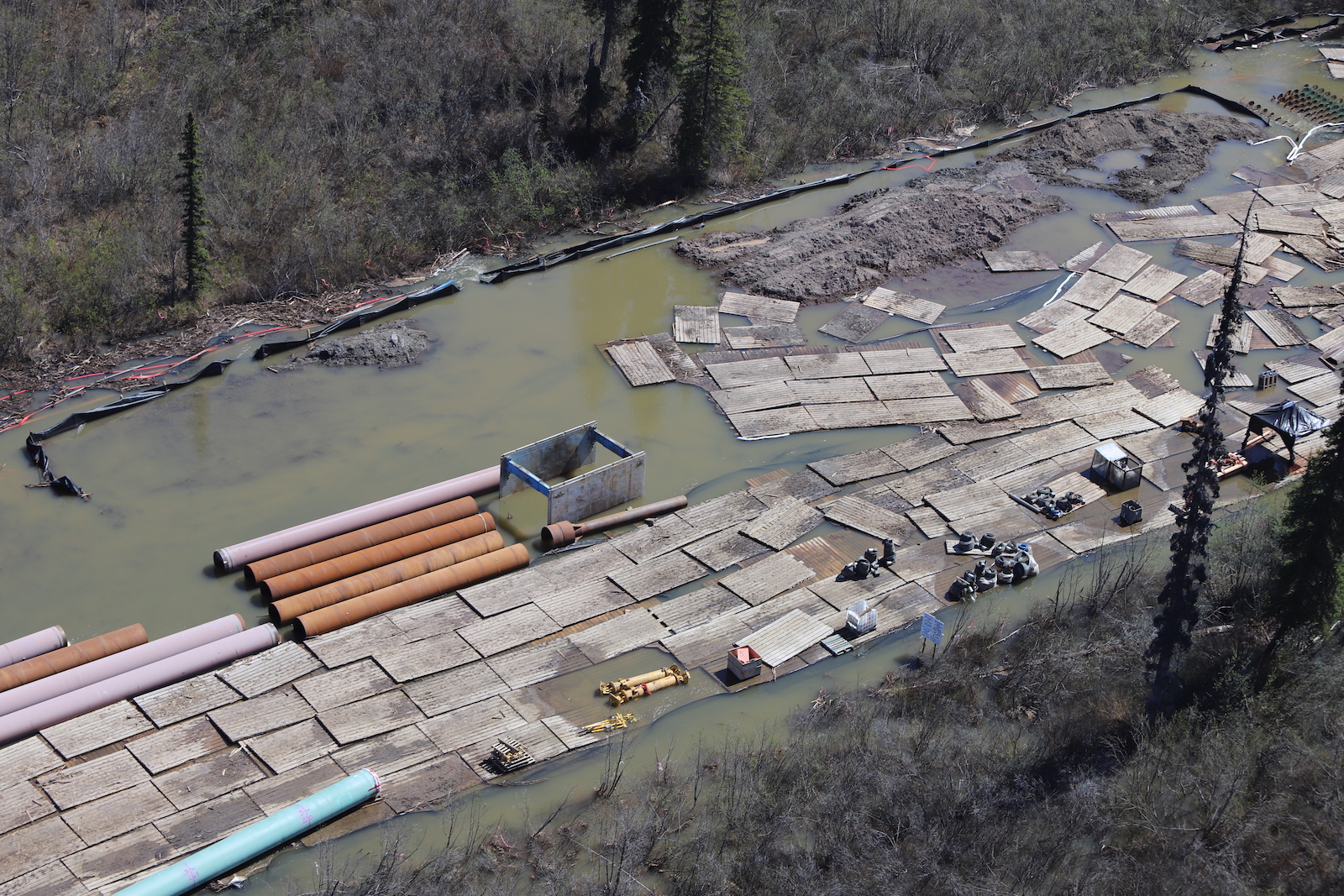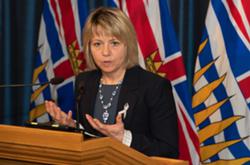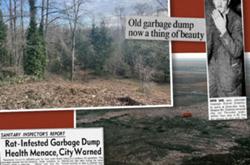Pipeline construction has been suspended for months in three kilometres of the Coastal GasLink route north of Prince George.
On Thursday, B.C.’s Environmental Assessment Office lifted additional stop-work orders in a 14-kilometre stretch directly east of the remaining work stoppage. The company said Friday morning that construction had resumed in those sections.
It announced in May that it had proactively suspended construction to focus on erosion and sediment-control issues in the almost 20-kilometre stretch of the Anzac River valley. One of five stop-work orders issued for the area in early May remained in effect on Friday.
But are the measures working?
The Ministry of Environment and Climate Change Strategy announced that it had signed a compliance agreement with Coastal GasLink on July 14, 2022, saying the EAO and Coastal GasLink had “jointly recognized” the need to address ongoing issues with erosion and sediment-control along the 670-kilometre pipeline route, which the company says is now 90-per-cent complete across northern B.C.
The agreement appeared to get off to a rocky start last fall, as the first order issued under it led to conflicting statements from the company and the EAO about whether the project was out of compliance and if work was required to stop. Work did stop, briefly, before Coastal GasLink determined it had been brought back into compliance.
This spring, ongoing non-compliance led to escalating enforcement measures, the EAO said. The measures included a wave of new orders in May, many of them requiring the company to stop construction. It also imposed a new requirement that work remain suspended until compliance and enforcement officers had inspected the project in person.
Environment Minister George Heyman declined The Tyee’s interview request to discuss the agreement, but an EAO spokesperson said via email that the environmental regulator has observed increased compliance with more rigorous requirements and oversight under the agreement.
But given the province’s dry conditions, those improvements are unlikely to be tested until wet weather returns.
“Our hope is that the past spring has been a learning experience for CGL and that we will see better management of erosion and sediment control as a result,” the EAO spokesperson said.
The agreement requires Coastal GasLink to enhance staff training and develop detailed erosion and sediment-control “work execution plans,” which are reviewed by an independent expert and approved by the EAO before work can proceed. It applies to roughly 100 kilometres, divided into 32 sections across the 670-kilometre pipeline route in areas where right-of-way clearing had not yet begun.
The requirements are in addition to any regular erosion and sediment-control requirements under the project’s environmental certificate, which was granted in 2014.
The pipeline’s controversial drill site at the Morice River crossing, where construction was already underway, is excluded from the agreement. Wet’suwet’en traditional leadership, which opposes the project, shared its concerns over sedimentation in the river, known as Wedzin Kwa, with The Tyee back in 2008, prior to Coastal GasLink being proposed.
Erosion and sediment-control issues were first flagged by EAO inspectors in October 2020. An order issued in December that year required Coastal GasLink to implement measures to control sediment flowing into sensitive watersheds and hire an independent auditor to monitor the issues.
Over the years that followed, the company struggled to bring the problems under control, resulting in additional orders and warnings. Three fines totalling over $450,000 have been issued to the project, the most recent in January.
Four additional penalties have been referred to a statutory decision-maker. The complex legal process takes time and careful consideration, an EAO spokesperson said.
“Any urgent issues identified during inspections that may be an immediate risk are addressed right away on-site and/or through warnings and orders,” the EAO added.
In addition, Coastal GasLink was charged $90,000 in inspection fees this spring.
Over the past year since the agreement was signed, the province has issued 15 orders against the project, all of them related to erosion and sediment control. Of those, nine were issued directly under the agreement and a dozen required that work on the project stop in specific areas until the issues were resolved.
All but one was issued during wet weather and spring run-off that created issues for the project in May.
The first order, issued last October three months after the agreement was signed, caused confusion as Coastal GasLink and the province appeared to be at odds about whether work was actually required to stop.
An email circulated Oct. 14 within the EAO cautioned not to use the phrase “stop-work order.”
“It is very important that this is NOT portrayed as a ‘Stop Work Order.’ It isn’t. It just mirrors the agreement and requires them to do no construction unless in compliance with the order,” it said. “We will inspect to verify compliance with the order. We will not be ‘permitting’ work to resume.”
As such, it was initially left up to the company to determine when the project was brought back into compliance.
On Oct. 25, Coastal GasLink told The Tyee it was still trying to understand “the specifics behind this order,” although internal government communications show the province met with company representatives to debrief them on Oct. 19. No work had stopped, it said.
“Coastal GasLink understands that we were and continue to be compliant with this order,” a spokesperson said.
That appeared to contradict statements from the EAO, which said inspectors had found “instances of non-compliance” where sediment-control measures varied from approved work plans. It said Coastal GasLink could resume once work was realigned to comply with approved plans or plans were amended and approved by the EAO.
On Oct. 28, two weeks after the order was issued, work on the pipeline "temporarily paused" in three areas totalling about 10 kilometres along the Anzac River north of Prince George. The next day, in an email to his colleagues, EAO deputy compliance and enforcement director Chris Parks outlined “significant concerns” following his on-site inspection in the area.
“Check dams are significantly outside the scope of the specifications for this measure in every instance. The one location where check dams were specified and the slope was correct, they were not installed,” Parks wrote about erosion and sediment-control measures. “There are locations where measures prescribed in the plan are missing.”
Two days later, work had resumed.
“We identified areas where erosion and sediment control measures required additional work to address compliance concerns,” Coastal GasLink told The Tyee on the evening of Oct. 31. “We continue to address those areas and maintain close contact with the EAO.”
At the time, Coastal GasLink was responsible for determining when the project was brought back into compliance.
But that changed with the issuing of a dozen stop-work orders this spring, after the EAO escalated enforcement “when ongoing non-compliance with erosion-control requirements was identified in some areas during routine inspections,” according to the EAO spokesperson.
The EAO then began using the term “stop-work orders” and required on-site inspection before work could resume.
The stop-work orders, which were issued between April 28 and May 31, focus on two areas — the Anzac River valley, where the October non-compliances were found, and an 11-kilometre section that skirts Gosnell Creek, a tributary of the Morice River.
In May, the Narwhal reported on a monitoring flight of the pipeline route that showed sections of pipe and other construction equipment submerged in murky floodwaters. An EAO inspection later confirmed “no evidence of mass sediment movement offsite” from the flooding.
Two stop-work orders were issued for the Gosnell area. The first, issued May 9, required work to stop in the 11-kilometre section but excluded work underway at the Gosnell Creek crossing. It was replaced on May 31 by a new order that included the crossing. Both orders were lifted in early June.
As of Friday, the province had lifted all but one of its stop-work orders. Three additional orders in specific locations north of Vanderhoof and Prince George require the company to implement erosion and sediment control measures but have not required work to stop. They remain in effect.
Coastal GasLink did not respond directly to The Tyee’s questions about whether the compliance agreement had been helpful in controlling run-off, or how confident the company is that erosion and sediment-control measures will be effective when wet weather returns.
In an emailed statement, a spokesperson said the company has worked closely with the EAO over the past year to improve erosion and sediment-control measures. It called the project complex, adding that it is “subject to some of the most stringent regulatory requirements in the world.”
“Erosion and sediment control is a constantly changing challenge,” the spokesperson wrote, adding that over 750 workers have completed erosion and sediment control training.
The company also said in a post on its website that it has launched a third-party review of erosion and sediment-control plans in Section 3, the Anzac River section where a stop-work order remains in effect. “This review will help us identify if any additional measures are required to support our response, and learnings will be applied across the project,” it said.
Coastal GasLink says it remains on track to complete construction later this year.
* Story updated on Aug. 9 at 11:33 a.m. to remove the main photo, which showed turbid water flowing from Gosnell Creek into the Morice River. An EAO report published after this story came out found that the washout observed in Gosnell Creek was unrelated to CGL activities. ![]()
Read more: Energy, Environment

















Tyee Commenting Guidelines
Comments that violate guidelines risk being deleted, and violations may result in a temporary or permanent user ban. Maintain the spirit of good conversation to stay in the discussion and be patient with moderators. Comments are reviewed regularly but not in real time.
Do:
Do not: